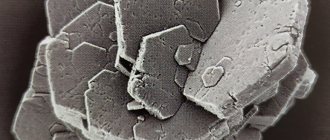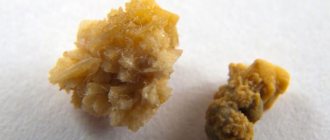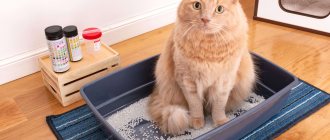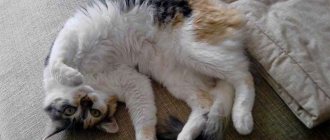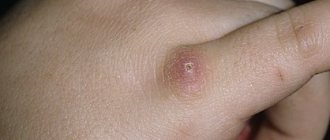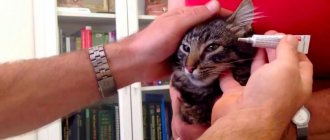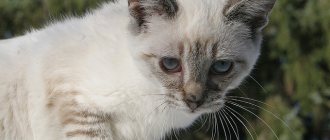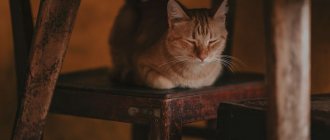Save article:
Urolithiasis (UKD) or urolithiasis is a serious disease of the excretory system in which sand and urinary stones accumulate in the cat's bladder, kidneys or ureters. The disease not only worsens the well-being of animals, causing them to suffer, but also directly threatens life. ICD has a certain set of symptoms that can be used to suggest the development of pathology. In case of a confirmed diagnosis, veterinarians use complex therapy and recommend effective measures to prevent urolithiasis.
Causes of ICD
There are many factors that contribute to the development of urolithiasis. All reasons are conventionally divided into external and internal. In this case, a combination of several provoking conditions is possible.
Exogenous
External causes are related to the living conditions, activity, and nutrition of the cat. One of the first places is irrational nutrition. An imbalance of proteins, fats, and carbohydrates leads to a shift in urine pH to the acidic or alkaline side. In both cases, solid conglomerates begin to form in the urinary organs. Vitamin deficiencies are also related to diet. All biologically active substances are important, but this is most true for vitamins A and D. Vitamin deficiency leads to metabolic disorders.
Thirdly, the lack of water and/or the high saturation of the liquid with minerals affects it. This factor affects the concentration of urine. In a more saturated liquid, solid inclusions form faster. The need for water increases if the cat lives in hot home conditions.
For some scrupulous cats, the cleanliness of the tray is important. Dirty litter makes the animal endure. Retention of urination provokes and accelerates stone-forming processes in the urine. In this case, signs of the disease appear faster.
Urolithiasis in cats is most often recorded at the very beginning of autumn, as well as in January-April.
Endogenous
Hormonal disorders can lead to the development of urolithiasis in cats. Internal causes also include diseases of the digestive system. If the food contains enough nutritional and biologically active compounds, but the cat has intestinal problems, the valuable substances will be poorly absorbed by the body. It is endogenous reasons that explain why cats of one breed or another are prone to urolithiasis. A set of genes, changes in their activity or structure influence the occurrence and rate of progression of urolithiasis in cats.
ICD - statistics and background
Urolithiasis is a disease that occurs under the influence of many interrelated phenomena, rather than any single cause. That is why during treatment you have to work on several “fronts” at once. Two types of factors influence the development of the disease:
- Endogenous - those that act from the inside.
- Exogenous – causes from outside.
photo from the site: arhcat.ru
ICD is most often diagnosed between the ages of one and six years. More often, cats are brought to see a veterinarian - the peculiarities of the anatomical structure of the urinary system organs in males make them the No. 1 target for a dangerous disease. Cats suffer less from it, but this does not eliminate the risk of developing the disease in females. Exacerbations occur in autumn and spring. Recently, visits to veterinary clinics with KSD have become more frequent. Experts attribute this to a number of factors:
- Changes in the diet of domestic cats and kittens (the predominance of dry food in the diet, often of low quality).
- The sedentary lifestyle of pets, whose pastime is reduced to alternating wakefulness in a static position and sleep.
- The emergence of new breeds that are characterized by a genetic predisposition to the disease. Also, many of them do not have time to adapt to unfavorable climatic conditions.
- Ecological deterioration - not only people, but also their pets suffer from environmental pollution.
- The presence of chronic urinary tract infections.
Symptoms of urolithiasis in cats
global $ads_google; //data-ad-slot=”2475549904″ $ads_google = empty($ads_google) ? false : true; ?> if ($ads_google == false) {?>
$ads_google = true; ?> } ?>
Problems with the lower part of the excretory system manifest themselves in behavioral signs at the earliest stages. The cat becomes apathetic and its appetite may change. The more the disease progresses, the more obvious the symptoms appear. In this regard, three symptomatic periods are distinguished: early, acute and critical. At the first stage, when sand and stones are already present in the bladder, urolithiasis in cats can be judged by the following signs:
- The pet goes to the toilet more often, and sometimes in the wrong places.
- Urination occurs in a tense position.
- While in the litter box, the cat meows from the pain caused by the stones.
- The presence of blood cells causes the urine to turn pink.
- The cat takes longer than usual to lick itself under its tail.
During the severe (acute) stage, these symptoms become even more obvious and others join them. The animal has urinary incontinence in a small volume, and the color of the liquid itself becomes more saturated. Urine acquires a specific unpleasant odor. Touching the belly causes pain in the cat. Body temperature jumps to 39-40 degrees.
In critical condition, the signs of urolithiasis worsen even more. The pet practically does not go to the toilet, and the urge causes severe attacks of pain. An overfilled bladder can lead to rupture and peritonitis. Viscous, foamy saliva is released from the mouth, and vomiting is possible. The temperature drops to 35-36 degrees. Body tremors and convulsions are added to apathy and lethargy. In the most severe cases, loss of consciousness is possible.
Read also
Cystitis in a cat. Symptoms and treatment
Cystitis is an inflammation of the bladder. It is a disease of the genitourinary system that occurs not only in humans, but also in animals.
Castration of cats: pros and cons
Castration is the removal of the male gonads (testes in males, ovaries or ovaries and uterus in females)
Washing a cat: how to properly bathe an animal?
Many people know that bathing a cat can be difficult due to the animal’s excessive aggressiveness. Tabby pets have an innate fear of water, so when bathing
Worms in cats: symptoms, signs and treatment
The first signs of infection may be absent for some time or resemble manifestations of other diseases
Sterilizing a cat: at home or in the clinic?
Sterilization is an intervention as a result of which an animal (a cat in particular) loses its ability to reproduce
Treatment of urolithiasis at home
If you notice signs of urolithiasis in your cat, you should immediately contact the veterinary clinic. But you can use some home remedies to alleviate the symptoms. They help make the suffering animal feel better. A warm heating pad is placed on the stomach. After visiting the veterinary clinic, the owner’s duties include careful care of the animal. He is provided with only home conditions; walks are temporarily canceled. Great importance is attached to food, purified water, a clean tray, and compliance with the schedule for taking medications prescribed for treatment.
If you have urolithiasis, you should not massage your stomach in an attempt to relieve pain or speed up the progression of stones!
Drugs for treatment
The veterinarian prescribes drug therapy for the disease for each animal individually. It depends on the type of uroliths contained in the urinary tract, the form of the disease and the existing chronic pathologies in the four-legged patient.
The most effective drugs for the treatment of urolithiasis in cats:
- “Kotervin” is a herbal-based medicine that promotes the removal of salts and the dissolution of uroliths, has a diuretic and anti-inflammatory effect;
- antispasmodics – no-shpa, drotaverine and papaverine;
- sedatives, such as bromcamphor, sodium bromide;
- analgesics. In most cases, subcutaneous administration of a solution of analgin and ortofen is prescribed.
What to feed a cat with ICD
When treating a cat for urolithiasis, be sure to use special food for cats with urolithiasis. They have a balanced composition of nutrients, minerals and vitamins. The type of cat food is chosen depending on what stones have formed in the genitourinary system. Natural nutrition is selected individually, but in any case it is recommended to avoid seafood and dairy, as they are saturated with mineral salts.
Diet for oxalate stones
Food should contain a minimum of oxalic acid. If the pet is on homemade food, then offal (liver, kidneys), as well as dairy dishes containing a lot of calcium, should be temporarily excluded. The therapeutic diet includes meat, vegetable stew made from cauliflower, carrots, beets and pumpkin, and rice porridge. If you buy ready-made food for your cat, you need to carefully choose the variety. For oxalate stones, the following is suitable for a cat:
- Hill's Prescription Diet Feline K/D or X/D
- Royal Canin URINARY
- Eukanuba Oxalate Urinary Formula
Hill's Prescription Diet Feline X/D. It has a reduced concentration of calcium and phosphorus, but an increased amount of potassium citrate and soluble fiber. This dietary food should not be fed to pregnant cats, young kittens or cats with struvite crystallization. Hill's Prescription Diet Feline brand K/D is used for stones of any nature.
Royal Canin URINARY is used for both therapeutic and preventive nutrition. It increases urine output and inhibits the formation of stones. The food has limitations - high blood pressure and abnormalities in kidney function.
Eukanuba Oxalate Urinary Formula is a low-calorie dietary food with reduced calcium and fat content. Ingredients are chicken, turkey, egg, cornmeal. Wet food comes with fish. Contraindications include pregnancy, lactation, and under one year of age.
Diet for struvite
Phosphate stones, which form in an alkaline environment, require a change in pH to the acidic side. This is partly facilitated by medicinal food or a properly selected diet of natural products. The cat should not be fed dairy products (cottage cheese, cheese, milk), or egg yolks. It is recommended to prepare dishes from oatmeal, rice, liver, egg whites, lean beef and veal. An alternative could be:
- Hill's Prescription Diet Feline S/D, C/D
- Eukanuba Struvite Urinary Formula
Hill's Prescription Diet Feline S/D is a medicinal food that fully meets the nutritional requirements of this category of cats. The composition contains meat, chicken fat, rice, corn flour, starch. This food should not be offered to small kittens under one year old or pregnant cats.
Eukanuba Struvite Urinary Formula. It is used for struvite crystallization and tendency to fullness. Dry granules are made from corn grits, chicken, turkey, animal fat, and dried eggs. This variety is not given to pregnant and lactating females and small kittens.
Risk group
As a result of the studies, it was revealed that urolithiasis occurs in 12% of domestic cats. It rarely develops in animals under one year of age (only 2% of all cases). At risk are cats aged 2 to 6 years. After the age of seven, KSD is practically not diagnosed in castrated cats.
Cats are the most vulnerable to the disease. Cats get sick with urolithiasis 5 times less often. The fact is that the urinary tract of cats is three times thinner than that of cats. In addition, they have a curved S-shape. At risk are sterilized animals that lead a sedentary lifestyle and are overweight.
There are some breeds that, through the selection process, have received a genetic predisposition to ICD - these are Persians, Scottish, British and Himalayan cats.
Prevention of urolithiasis
After the cat’s treatment is completed, it is necessary to adhere to the rules of prevention for the rest of its life. It also doesn’t hurt to remember these measures if your pet is prone to urolithiasis. Prevention consists of proper selection of dietary food, drinking regimen, medications and folk remedies.
global $ads_google; //data-ad-slot=”2475549904″ $ads_google = empty($ads_google) ? false : true; ?> if ($ads_google == false) {?>
$ads_google = true; ?> } ?>
Food for the prevention of urolithiasis
The cat's nutrition should be organized taking into account the nature of the stones. Your cat should be fed premium ready-made food. The varieties that were used in treatment are also suitable for prevention. The same goes for a natural diet. Products that, during metabolism, acidify or, conversely, alkalize urine, are excluded from the diet. In any case, the cat's menu should not contain strong meat broths, sausages, fatty and salty foods. Food should be varied and nutritious.
Your pet should always have fresh water of low mineralization.
Medications
Many medications that are used to treat urolithiasis are also used for prevention. For this purpose, it is advisable to select products with natural composition. The best option is to consult a doctor. Preventive veterinary medications for urolithiasis include Kotervin, Urinari tract support, Furinite, Cantharis composite.
Kotervin removes salts, promotes better urine flow, relieves inflammation, dissolves stones (with the exception of oxalates). It contains only natural ingredients: extracts of horsetail, steelhead, knotweed and bird's eye.
Urinari tract support is a complex veterinary preparation based on bearberry, phylanthus, cranberry, marshmallow, dandelion, and corn silk. In addition to the salt-removing, diuretic and anti-inflammatory effects, Urinari has a mild immunomodulatory effect.
Folk remedies
The collection of traditional medicine offers many recipes that help improve the health of a cat that has had or is prone to urolithiasis. They are not potent drugs, but provide preventive support.
In the morning on an empty stomach, it is recommended to give the cat strawberry or carrot juice (1 teaspoon each). An infusion of lavender, birch, currant, hops, chamomile, plantain, horsetail and rosehip is also useful for oral administration. Herbs and fruits are taken in 5 grams each, then 5 grams of the collection is poured into 500 ml of boiling water. The pet is given 10 ml 2-3 times a day for a month.
When bathing, you can use a herbal bath, which is prepared from a collection of herbs (chamomile, dried grass, birch, oregano, sage, linden). For 500 ml of boiling water, take 1 gram of each type of plant material. The infusion is poured into a basin where the cat will bathe.
Prerequisites for MBC disease
Urolithiasis can occur in any animal. The following factors often lead to its appearance:
- Wrong diet. Low-quality economy class feeds lead to the emergence of urolithiasis. Their composition is poorly balanced, they do not contain all the necessary nutrients, and various substances harmful to animals are often added to them. Because of this, metabolic disorders occur, failure of the gastrointestinal tract, kidneys, and genitourinary system. The animal gains excess weight, and the urine becomes more concentrated, salts and stones form in it.
- Lack of free access to drinking water. Cats, by nature, rarely drink. Lack of fluid in the body causes urine to become more concentrated and stones begin to form. Lack of fluid is especially dangerous if the animal eats only dry food. Metabolic disorders and dehydration occur.
- Stress. Strong emotional experiences can lead to exacerbation of diseases that previously did not make themselves felt.
- Excess weight. Obese cats need to drink a lot more fluid, which they rarely do. This leads to problems with the genitourinary system.
- Other chronic diseases that affect the general condition of the body and metabolism.
- Lack of vitamin A. This often happens if the animal eats natural food, but there are no vitamin and mineral supplements in its diet. A meager diet poor in vitamins leads to decreased immunity and metabolic disorders.
- A urinary tract infection that often occurs due to poor hygiene or hypothermia.
- Genetic predisposition. A cat is born with an abnormality of the urinary tract, or internal organs responsible for metabolism and hormone levels.
- Climate. The room where the pet is located is very hot. Dehydration begins and urine becomes more concentrated. Irregular urination. Many cats are too clean to go into a dirty litter box. They endure, the concentration of urine increases, which leads to the formation of stones and other unpleasant consequences.
- Hormonal imbalance. This is especially true only for sterilized animals, which after surgery due to hormonal changes become much less mobile, but at the same time eat a lot and quickly gain excess weight.
We recommend the article: Prolapse of the third eyelid in a cat: causes and treatment
Methods for treating urolithiasis in cats
Treatment depends on the stage of the disease. If you consult a doctor in time, only a special diet may be sufficient. In the most advanced cases, surgical intervention cannot be avoided.
We recommend the article: The cat has black in the corners of its mouth: what could it be?
If the stones are small and pass on their own, you can do without drug treatment. It is important to strictly adhere to the diet prescribed by your doctor. The animal must have drinking water available at all times, and it is also important that the cat drinks this water.
It is necessary to protect the animal from all possible stress. If there are small children or other animals in the house, the cat should be temporarily isolated from them so that it is constantly at rest.
If you do not provide assistance to the animal in time, kidney failure may develop. Intoxication of the body may begin. If the urethra is blocked and the stones are not very large, its patency is restored with the help of medications. The animal is also given antispasmodics and antibiotics. Treatment is often symptomatic and depends on the severity of the cat’s condition.
To relieve spasm, muscle relaxants are often injected into the body directly through the urethra. The spasm passes, the walls of the urethra relax and the stone stuck in them leaves the body. If this method is ineffective, a catheter is inserted directly into the bladder, which helps get rid of accumulated urine and avoid intoxication of the animal’s body.
Surgical intervention is resorted to as a last resort. The operation is performed if large stones have accumulated in the urinary canal, which cannot be removed in the usual way. Or if the animal experiences frequent relapses of urolithiasis.
Depending on the indications, the doctor will choose one of the surgical methods:
- Cystotomy. The wall of the bladder is cut, after which all accumulated stones are removed from it and it is washed.
- Epicystomy. The wall of the bladder is opened, all stones are removed, a catheter is inserted, which will remove urine and other fluids for two weeks.
- Urethrostomy. This method is used if relapses occur due to the structural features of the cat’s genitourinary system. In this case, the testes, scrotum, penis and part of the urethra are removed. The walls of the urethra are also expanded. All this is necessary in order to avoid blockage of the urinary tract in the future.
